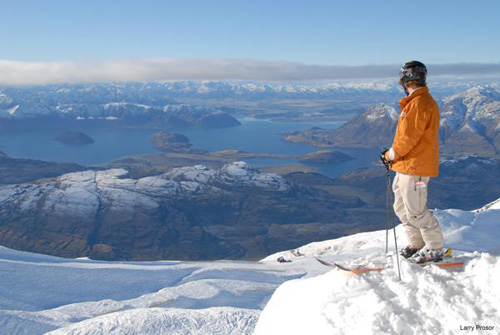As we start heading into the summer months, some ski resorts offer skiing on the permanent areas of snow and ice that remain in the higher altitudes. These areas are known as glaciers and in most ski resorts they are also functioning ski areas during the winter too.
Glacier Skiing During The Winter
Many ski resorts have glaciers located in the higher parts of their ski areas and during winter, they form part of the normal ski area that includes ski lifts and ski runs. Often skiers won’t even realise they are skiing on a glacier.
Although a huge part of a glacier might be made up of very hard snow or ice, during the winter in the Alps, large depths of snow will cover the surface and the conditions for skiing or snowboarding on the glaciers is often very good – they are not icy and in fact there’s more chance of experiencing icy piste conditions on the lower slopes of a resort.
One major challenge is building ski lifts on glaciers because of the lack of permanent rock for pylons and the fact the glacier will move over time. Modern ski lifts have been built on glaciers though, often cable cars that don’t require multiple pylons, or chairlifts that take advantage of strategic rock formations that are available.
Exceptions to this include the Furggsattel-Express chairlift in Zermatt with many of its pylons set into the ice, which are then moved as required.
The main potential danger of skiing on a glacier is the risk of falling into a crevasse. A crevasse is an open hole or gash in the ice, often very deep. If a skier falls into this hole they could become seriously injured and rescue is difficult and complicated. This is what it’s crucial that skiers remain on the marked trails when on glaciated terrain. Most ski resorts provide signage to warn skiers that they are on a glacier, but it’s best to avoid going off-piste or beyond the marked runs, especially on higher altitude slopes, unless you are totally sure it’s safe to do so, or you’re with a professional qualified mountain guide.
During the winter months, crevasses can be hidden by fresh snow so they are very difficult to spot.
Only qualified UIAGM mountain guides can take skiers off-piste (beyond the marked runs) on glaciers. Even the very highest qualified ski instructors are not allowed to take their clients off-piste on glaciers.
Ski resorts where you might expect to ski on glaciers during the Winter include: Val d’Isère, Tignes, La Plagne, Argentiere, Les 2 Alpes (France) – Zermatt, Saas Fee, Verbier, Andermatt (Switzerland), Sölden, Hintertux, Ischgl (Austria) and Cervinia, Alagna, Arraba (Italy).
Glacier Skiing During The Summer And Autumn
Some ski resorts also open the glaciated terrain during the Summer months, usually June and July, and then from October onwards.
Because of global warming, many of the glaciers in The Alps and across Europe are receding – leaving summer ski areas struggling to remain open. Some have been forced to close completely, others have seen the summer season shortened. It’s not clear what the future holds for summer skiing in Europe, but unless we have a reversal of global warming it’s unlikely to improve.
Norway has some excellent summer season skiing on its glaciers, including Fonna, which in 2020 opened on May 1 with a large ski base. The Fonna Glacier ski area usually stays open until September.
Other major European resorts with glacier skiing during the summer include Tignes, Zermatt, Saas Fee, Mölltal and Hintertux.
Conditions on the glaciers during the summer can vary hugely – it’s very much weather dependant. During the middle of summer, it’s common to experience icy conditions during the morning and wet slushy ‘snow’ during the afternoon. Most glaciers open early in the morning and close around lunchtime. Because glaciers tend to be at high altitudes, even in summer it’s possible to get snowfall, so conditions can be good too.
Whilst any level of skier or snowboarder can experience skiing on glaciers during the summer, it’s worth considering a few things:
- Ski schools are not very active during this period (although British ski course companies are – see below).
- The ski areas are very limited (although combining some skiing with summer mountain activities is an option).
- There’s often a large amount of ski racers training on the glaciers and they take up a lot of space.
- Many hotels and restaurants might not open in some resorts, depending on the time of year.
Very few organised tours available for summer skiing, so independent travel is required.
Some of the benefits include lower accommodation costs than in winter, relaxed atmosphere in the resort, activities such as mountain biking, hiking and rock climbing available, sunny warm days.
Booking: inghams.co.uk
Summer Skiing Courses: Snoworks Ski Courses (Tignes, France).






